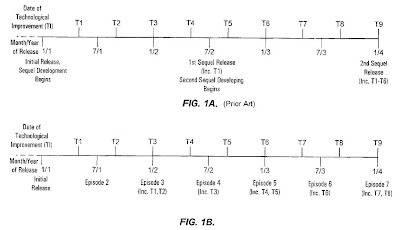U.S. Pat. No. 6,992,654: System and method for providing user input to character animation
Issued January 31, 2006, to Electronic Arts Inc.
Summary:
This EA patent involves systems and methods for providing user input to character animations. The inputs are processed in real-time and allow for improved user control and visual feedback on the movement being animated. Whenever a player uses a joystick to move, one of a list of animations is selected and the figure on the screen reacts instantaneously to the command, created a seamless movement on the screen.
Abstract:
The present invention provides a system that increases a user's control over character animation. Time-dependent signals are accepted from a user input device. The input is processed in real-time such that the user's input can be used to directly control the animation of an animated character. For example, the animation of a three-dimensional rendered character swinging a golf club in a golf game can be changed in mid-swing according to the user's operation of an input device. In general the system accepts user continuous and real-time user input. The user is given improved control and visual feedback on the movement being animated. One embodiment of the invention includes an analog input module, a control state machine module and an animation state machine module. The analog input module is configured to receive user analog input (e.g., from an analog joystick) related to animated character display and to normalize the user analog input to create a normalized user analog input.
Illustrative Claims:
1. A system for providing user input for animated character display on an animation display system comprising: an analog input module configured to receive user analog input related to animated character display and to normalize the user analog input, thereby creating normalized user analog input; a control state machine module configured to receive normalized user analog input from the analog input module and create a time-based state based on the received normalized analog input, the time-based state modeling an intent of the user with respect to the animated character; and an animation state machine module configured to receive the time-based state from the control state machine module and to create a list of animations and at least one blending percentage for combining the list of animations based on the time-based state, and providing the list of animations and at least one blending percentage to the animation display system.
7. A method for providing user input for animated character display on an animation display system comprising: receiving user analog input related to animated character display and normalizing the user analog input, thereby creating normalized user analog input; creating a time-based state based on the normalized analog input, the time-based state modeling an intent of the user with respect to the animated character; preparing a list of animations and at least one blending percentage for combining the list of animations based on the time-based state, and providing the list of animations and at least one blending percentage to an animation display system for controlling character animation.










